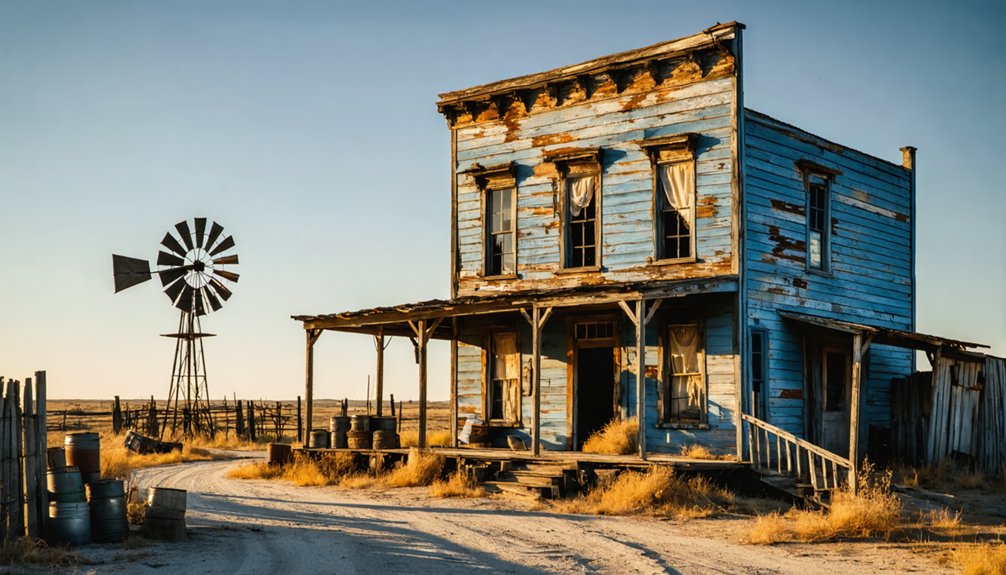You’ll find Nogal among Wilson County’s forgotten ghost towns, where a once-thriving agricultural community flourished in the late 1800s. The settlement, named from the Spanish word for “walnut,” began with a post office in 1858 as Nogallis Prairie. The town centered on cotton farming, with general stores and depots serving as social hubs for hundreds of residents. Today, only sparse foundations, weathered grave markers, and native vegetation mark this piece of Texas frontier history.
Key Takeaways
- Nogal was a 19th-century settlement in Wilson County, Texas, initially established as Nogallis Prairie with its first post office in 1858.
- The town flourished as an agricultural community focused on cotton farming, with general stores and depots serving as economic centers.
- Economic instability, changing transportation routes, and rising property taxes contributed to the town’s eventual decline and abandonment.
- Today, only sparse structural remnants and weathered grave markers in the old cemetery remain as evidence of the former settlement.
- The ghost town represents one of Wilson County’s 31 abandoned settlements and serves as a testament to Texas’s frontier development.
A Lost Town in Wilson County
While many Texas ghost towns have left detailed historical records, Nogal stands as one of Wilson County‘s more enigmatic lost settlements.
Nogal remains a mysterious footnote in Texas history, its story lost among Wilson County’s forgotten frontier settlements.
You’ll find it’s part of an impressive legacy, as Wilson County holds Texas’s record for ghost towns with 31 documented sites. The county’s rich ghost town culture emerged from its 1860 establishment, when settlers first concentrated along Ecleto and Cibolo creeks.
When you explore Nogal’s history, you’ll discover it’s shrouded in mystery. Like its neighboring ghost towns, it likely developed around essential waterways or transportation routes. Similar to Helena’s history, the town may have once served as a vital stopping point between major cities. Much like at Carnton Plantation, the area may contain visible remnants of its former inhabitants.
While specific details about Nogal’s location and peak population remain elusive, it represents the broader pattern of frontier settlements that once dotted Wilson County’s landscape, serving as significant waypoints in early Texas development.
Origins and Early Settlement
Although Nogal’s exact founding date remains uncertain, historical records indicate settlement began in the late 19th century as pioneers sought agricultural opportunities in Wilson County’s fertile prairie lands.
The town’s name reflects its rich cultural influences, derived either from the Spanish word for “walnut” tree or, as local lore suggests, from a frontier justice incident where horse thieves were hung without a gallows. The area was known as Nogallis Prairie when its first post office opened in 1858. Like many Texas settlements of the era, the town’s post office closed within a few years of its establishment.
Pioneer experiences centered on agriculture, ranching, and timber operations, with both Anglo-American and Hispanic settlers establishing homesteads in the area.
You’ll find that early infrastructure was minimal, with dirt trails connecting scattered farms and ranches. The community relied heavily on self-sufficiency, operating through informal governance and basic trade networks due to its remote location and lack of railroad access.
Life Before the Decline
Before its eventual decline, Nogal thrived as a modest agricultural community centered around cotton farming along the Guadalupe River.
You’d find general stores and depots serving as hubs where farmers and merchants gathered, while local banks and a post office provided crucial services.
The town’s social fabric was woven through churches, schools, and seasonal festivities, demonstrating remarkable community resilience despite agricultural challenges like droughts and the boll weevil.
If you’d visited during its peak, you would’ve encountered several hundred residents, including multi-generational farming families working the fertile riverside soil.
While lacking modern utilities, the town maintained its liveliness through shared hardships and cooperative spirit, with social life revolving around informal gatherings at saloons and community events at the schoolhouse. Much like The Grove’s stagecoach stop, Nogal relied heavily on passing travelers to sustain its local economy. Similar to Thurber’s system, workers were paid with company scrip that could only be used at local stores.
Forces Behind the Exodus
The gradual unraveling of Nogal’s community fabric stemmed from multiple interconnected forces that accelerated its decline.
You’ll find that economic instability hit the town particularly hard when agricultural conditions deteriorated and transportation routes shifted away from the area. Rising property tax burdens compounded the financial strain on remaining residents. The lack of infrastructure investment made it increasingly difficult for local businesses to survive, while the closure of essential services like schools and medical facilities dealt additional blows to the community’s sustainability. Modern user verification systems could have helped authenticate and track the remaining population more accurately.
Demographic shifts played a significant role in Nogal’s exodus, as younger residents sought opportunities in larger urban centers.
You can trace the town’s abandonment to an aging population, limited job prospects, and the broader rural-to-urban migration patterns that affected many Texas communities during this period. The combination of these factors created a downward spiral from which Nogal couldn’t recover.
What Remains Today
While exploring Nogal today, you’ll find sparse remnants of its former existence scattered across the Texas landscape. You might discover a few difficult-to-locate foundations or footings that hint at where buildings once stood, along with occasional rubble piles marking former structural remains. Many of these structures fell victim to economic hardships when key industries disappeared.
The site is mostly reclaimed by native desert vegetation, with weathered grave markers in the old cemetery offering silent testimony to those who once called this place home. Like semi-abandoned towns such as Welfare and Whiteway, Nogal has largely faded from memory.
You’ll notice the surrounding environment has largely reverted to its natural state, with vast desert views and rocky cliffs dominating the horizon. Due to private ownership, you may encounter fences or property markers restricting access to any visible ruins.
No permanent residents remain, though occasional visitors still venture to this remote piece of Texas history.
Legacy Among Texas Ghost Towns
Among the scattered ruins of Texas ghost towns, Nogal stands out as a significant example of late 19th-century boom-and-bust settlement patterns.
You’ll find its cultural significance deeply rooted in the region’s mining heritage, where iron ore extraction once drove local prosperity. Like many of its contemporaries, Nogal’s economic impact extended beyond mere industry – it was part of the broader story of frontier development, political contests, and territorial expansion.
When you explore Nogal’s legacy today, you’re witnessing more than just abandoned buildings.
You’re seeing evidence of the dynamic forces that shaped Texas: the competition for county seats, the rise and fall of mining operations, and the profound impact of transportation changes.
Nogal’s story continues to enrich our understanding of how resource-dependent communities influenced Texas’s development.
Preserving Nogal’s Memory

Since its decline, preserving Nogal’s memory has become a collaborative effort between historical societies, community groups, and dedicated volunteers.
Through historical documentation efforts, you’ll find digitized newspapers, photographs, and local records that tell the story of this once-thriving Texas community. These materials are now carefully curated for public access and research.
Community engagement plays an essential role in keeping Nogal’s heritage alive. You can participate in guided tours and educational programs that bring the town’s past to life.
Local schools use the site as an outdoor classroom, while descendants share oral histories during heritage events.
Despite challenges with funding and ownership issues, preservation groups work tirelessly to protect remaining structures and artifacts, ensuring that Nogal’s contribution to Texas history won’t be forgotten.
Frequently Asked Questions
Are There Any Supernatural Legends or Ghost Stories Associated With Nogal?
Like shadows haunting memories, you’ll hear local folklore of ghost sightings among abandoned buildings, with witnesses reporting mysterious lights, unexplained footsteps, and eerie figures drifting through the desert darkness.
What Is the Closest Major City or Highway to Nogal Today?
You’ll find Amarillo’s your closest major city, about 70-80 miles southwest. While historical significance has faded, travel accessibility remains through FM 281, connecting you to regional transportation networks.
Can Visitors Legally Explore the Remaining Structures in Nogal?
You can legally explore the concrete steps from public roads, as no exploration permits or visitor guidelines restrict access. However, respect any private property boundaries you might encounter.
Are Any Original Nogal Families Still Living in the Area?
You won’t find documented evidence of original Nogal descendants still living in the area. Nogal history shows most families left when the town declined, with no confirmed continuous family presence today.
Does Nogal Appear on Modern Texas Maps and GPS Systems?
You won’t find Nogal on most modern Texas maps or standard GPS systems. As a ghost town, it’s typically only included in specialized mapping technology focused on historical or abandoned locations.
References
- https://mix941kmxj.com/see-how-two-texas-ghost-towns-battled-for-the-county-and-lost/
- https://www.youtube.com/watch?v=phjUE19A8HM
- https://txprobatelawyer.net/the-rise-of-ghost-towns-can-you-own-a-piece-of-abandoned-texas/
- https://jamesbigleyranches.com/general/texas-ghost-towns/
- https://texashighways.com/travel-news/four-texas-ghost-towns/
- https://en.wikipedia.org/wiki/List_of_ghost_towns_in_Texas
- https://www.texasalmanac.com/places/nogal
- https://mix931fm.com/texas-ghost-towns-history/
- https://www.texasescapes.com/TexasHillCountryTowns/Anhalt-Texas.htm
- https://www.county.org/county-magazine-articles/summer-2025/ghost-towns



